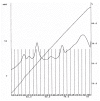Identification of a Bacillus thuringiensis Cry11Ba toxin-binding aminopeptidase from the mosquito, Anopheles quadrimaculatus
- PMID: 16716213
- PMCID: PMC1533836
- DOI: 10.1186/1471-2091-7-16
Identification of a Bacillus thuringiensis Cry11Ba toxin-binding aminopeptidase from the mosquito, Anopheles quadrimaculatus
Abstract
Background: Aminopeptidase N (APN) type proteins isolated from several species of lepidopteran insects have been implicated as Bacillus thuringiensis (Bt) toxin-binding proteins (receptors) for Cry toxins. We examined brush border membrane vesicle (BBMV) proteins from the mosquito Anopheles quadrimaculatus to determine if APNs from this organism would bind mosquitocidal Cry toxins that are active to it.
Results: A 100-kDa protein with APN activity (APNAnq 100) was isolated from the brush border membrane of Anopheles quadrimaculatus. Native state binding analysis by surface plasmon resonance shows that APNAnq 100 forms tight binding to a mosquitocidal Bt toxin, Cry11Ba, but not to Cry2Aa, Cry4Ba or Cry11Aa.
Conclusion: An aminopeptidase from Anopheles quadrimaculatus mosquitoes is a specific binding protein for Bacillus thuringiensis Cry11Ba.
Figures



References
-
- Ye-Ebiyo Y, Pollack RJ, Spielman A. Enhanced development in nature of larval Anopheles arabiensis mosquitoes feeding on maize pollen. Am J Trop Med Hyg. 2000;63:90–93. - PubMed
-
- Bates M. The natural history of mosquitoes. New York , The Macmillan Company; 1949. p. 379.
-
- Sangadala S, Walters FS, English LH, Adang MJ. A mixture of Manduca sexta aminopeptidase and phosphatase enhances Bacillus thuringiensis insecticidal CryIA(c) toxin binding and 86Rb+-K+ efflux in vitro. J Biol Chem. 1994;269:10088–10092. - PubMed
-
- Vadlamudi RK, Ji TH, Bulla LAJ. A specific binding protein from Manduca sexta for the insecticidal toxin of Bacillus thuringiensis subsp. berliner. J Biol Chem. 1993;268:12334–12340. - PubMed
Publication types
MeSH terms
Substances
Grants and funding
LinkOut - more resources
Full Text Sources
Research Materials
Miscellaneous

